Pollination Potential in Portugal: Leveraging an Ecosystem Service for Sustainable Agricultural Productivity
Abstract
1. Introduction
2. Materials and Methods
2.1. Study Area
2.2. Software and Data Management
2.3. InVEST Crop Pollination Model
2.4. Spatial Data
2.5. Validation
3. Results
3.1. Land Use Land Cover Evolution from 1990 to 2018
3.2. Pollinator Abundance and Supply Indices
3.3. Pollination Service Changes from 1990 to 2018
3.4. Validation
4. Discussion
4.1. Study Significance
4.2. Critical Analysis
4.3. Additional Findings
4.4. Research Limitations
4.5. Future Opportunities
5. Conclusions
Author Contributions
Funding
Institutional Review Board Statement
Informed Consent Statement
Data Availability Statement
Acknowledgments
Conflicts of Interest
Appendix A. Model Parameterization
| Classes | Nesting Resourses | Floral Resourses | PSIRL Final Scores |
|---|---|---|---|
| Riparian scrubland | 0.8 | 0.9 | 0.83 |
| Broad-leaved forest | 0.8 | 0.9 | 0.83 |
| Natural grassland | 0.8 | 1 | 0.81 |
| Moors and heathland | 0.8 | 1 | 0.81 |
| Sclerophyllous vegetations | 0.8 | 1 | 0.81 |
| Transitional woodland scrub | 0.8 | 1 | 0.81 |
| Riparian forest | 0.8 | 0.5 | 0.78 |
| Fruit trees and berry plantations | 0.4 | 0.9 | 0.6 |
| Olive groves | 0.5 | 0.4 | 0.6 |
| Mixed forest | 0.8 | 0.6 | 0.55 |
| Sparsely vegetated areas | 0.7 | 0.35 | 0.52 |
| Inland marshes | 0.3 | 0.75 | 0.52 |
| Salt marshes | 0.3 | 0.55 | 0.52 |
| Coniferous forest | 0.8 | 0.3 | 0.49 |
| Annual crops associated with permanent crops | 0.4 | 0.5 | 0.47 |
| Complex cultivation patterns | 0.4 | 0.4 | 0.47 |
| Land principally occupied by agriculture | 0.7 | 0.75 | 0.47 |
| Agro-forestry areas | 1 | 0.5 | 0.47 |
| Non-irrigated arable land | 0.2 | 0.2 | 0.39 |
| Permanently irrigated land | 0.2 | 0.05 | 0.39 |
| Rice fields | 0.2 | 0.05 | 0.39 |
| Pastures | 0.3 | 0.2 | 0.39 |
| Continuous urban fabric | 0.1 | 0.05 | 0.23 |
| Discontinuous urban fabric | 0.3 | 0.3 | 0.23 |
| Industrial or commercial units | 0.1 | 0.05 | 0.23 |
| Road and rail networks | 0.3 | 0.25 | 0.23 |
| Port areas | 0.3 | 0 | 0.23 |
| Airports | 0.3 | 0 | 0.23 |
| Mineral extraction sites | 0.3 | 0.05 | 0.23 |
| Dump sites | 0.05 | 0 | 0.23 |
| Green urban areas | 0.3 | 0.25 | 0.23 |
| Sport and leisure facilities | 0.3 | 0.05 | 0.23 |
| Vineyards | 0.4 | 0.6 | 0.2 |
| Burnt areas | 0.3 | 0.2 | 0.13 |
References
- Costanza, R.; D’Arge, R.; de Groot, R.; Farber, S.; Grasso, M.; Hannon, B.; Limburg, K.; Naeem, S.; O’Neill, R.V.; Paruelo, J.; et al. The Value of the World’s Ecosystem Services and Natural Capital. Nature 1997, 387, 253–260. [Google Scholar] [CrossRef]
- Chaplin-Kramer, R.; Sharp, R.P.; Weil, C.; Bennett, E.M.; Pascual, U.; Arkema, K.K.; Brauman, K.A.; Bryant, B.P.; Guerry, A.D.; Haddad, N.M.; et al. Global Modeling of Nature’s Contributions to People. Science 2019, 366, 255–258. [Google Scholar] [CrossRef]
- Grafius, D.R.; Corstanje, R.; Harris, J.A. Linking Ecosystem Services, Urban Form and Green Space Configuration Using Multivariate Landscape Metric Analysis. Landsc. Ecol. 2018, 33, 557–573. [Google Scholar] [CrossRef]
- Johnson, J.A.; Baldos, U.; Hertel, T.; Liu, J.; Nootenboom, C.; Polasky, S.; Roxburgh, T. Global Futures: Modelling the Global Economic Impacts of Environmental Change to Support Policy-Making; WWF UK: Woking, UK, 2020. [Google Scholar]
- Patrício-Roberto, G.B.; Campos, M.J.O. Aspects of Landscape and Pollinators-What Is Important to Bee Conservation? Diversity 2014, 6, 158–175. [Google Scholar] [CrossRef]
- Kennedy, C.M.; Lonsdorf, E.; Neel, M.C.; Williams, N.M.; Ricketts, T.H.; Winfree, R.; Bommarco, R.; Brittain, C.; Burley, A.L.; Cariveau, D.; et al. A Global Quantitative Synthesis of Local and Landscape Effects on Wild Bee Pollinators in Agroecosystems. Ecol. Lett. 2013, 16, 584–599. [Google Scholar] [CrossRef]
- Klein, A.M.; Vaissière, B.E.; Cane, J.H.; Steffan-Dewenter, I.; Cunningham, S.A.; Kremen, C.; Tscharntke, T. Importance of Pollinators in Changing Landscapes for World Crops. Proc. R. Soc. B 2007, 274, 303–313. [Google Scholar] [CrossRef] [PubMed]
- Zulian, G.; Maes, J.; Paracchini, M.L. Linking Land Cover Data and Crop Yields for Mapping and Assessment of Pollination Services in Europe. Land 2013, 2, 472–492. [Google Scholar] [CrossRef]
- Losey, J.E.; Vaughan, M. The Economic Value of Ecological Services Provided by Insects. BioScience 2006, 56, 311–323. [Google Scholar] [CrossRef]
- Picanço, A.; Gil, A.; Rigal, F.; Borges, P.A.V. Pollination Services Mapping and Economic Valuation from Insect Communities: A Case Study in the Azores (Terceira Island). Nat. Conserv. 2017, 18, 1–25. [Google Scholar] [CrossRef]
- Grafius, D.R.; Corstanje, R.; Warren, P.H.; Evans, K.L.; Hancock, S.; Harris, J.A. The Impact of Land Use/Land Cover Scale on Modelling Urban Ecosystem Services. Landsc. Ecol. 2016, 31, 1509–1522. [Google Scholar] [CrossRef]
- Greenleaf, S.S.; Williams, N.M.; Winfree, R.; Kremen, C. Bee Foraging Ranges and Their Relationship to Body Size. Oecologia 2007, 153, 589–596. [Google Scholar] [CrossRef]
- Groff, S.C.; Loftin, C.S.; Drummond, F.; Bushmann, S.; McGill, B. Parameterization of the InVEST Crop Pollination Model to Spatially Predict Abundance of Wild Blueberry (Vaccinium angustifolium) Native Bee Pollinators in Maine, USA. Environ. Model. Softw. 2016, 79, 1–9. [Google Scholar] [CrossRef]
- Lonsdorf, E.; Kremen, C.; Ricketts, T.; Winfree, R.; Williams, N.; Greenleaf, S. Modelling Pollination Services across Agricultural Landscapes. Ann. Bot. 2009, 103, 1589–1600. [Google Scholar] [CrossRef] [PubMed]
- Roxburgh, T.; Ellis, K.; Johnson, J.A.; Baldos, U.L.; Hertel, T.; Nootenboom, C.; Polasky, S. Global Futures: Assessing the Global Economic Impacts of Environmental Change to Support Policy-Making; WWF UK: Woking, UK, 2020. [Google Scholar]
- Santos, A.; Fernandes, M.R.; Aguiar, F.C.; Branco, M.R.; Ferreira, M.T. Effects of Riverine Landscape Changes on Pollination Services: A Case Study on the River Minho, Portugal. Ecol. Indic. 2018, 89, 656–666. [Google Scholar] [CrossRef]
- Koh, I.; Lonsdorf, E.V.; Williams, N.M.; Brittain, C.; Isaacs, R.; Gibbs, J.; Ricketts, T.H. Modeling the Status, Trends, and Impacts of Wild Bee Abundance in the United States. Proc. Natl. Acad. Sci. USA 2016, 113, 140–145. [Google Scholar] [CrossRef] [PubMed]
- Direção Geral do Território (DGT); Carta Administrativa Oficial de Portugal: Lisboa, Portugal, 2018.
- Camacho, I.; Caeiro, E.; Nunes, C.; Morais-Almeida, M. Airborne Pollen Calendar of Portugal: A 15-Year Survey (2002–2017). Allergol. Immunopathol. 2020, 48, 194–201. [Google Scholar] [CrossRef]
- Copernicus Program, CORINE Land Cover. Available online: https://land.copernicus.eu/paneuropean/corine-land-cover (accessed on 30 March 2020).
- ECA. Desertification in the EU.; Background Paper; European Court of Auditors (ECA)—Guardians of the EU Finances: Luxembourg, 2018. [Google Scholar]
- World Bank Open Data—Indicators. Available online: https://data.worldbank.org/indicator/SP.POP.TOT?locations=PT&most_recent_value_desc=true (accessed on 3 April 2020).
- Ciência Viva. Polinizadores em ação. Available online: http://www.cienciaviva.pt/aprenderforadasalaeaula/index.asp?accao=showobj&id_obj=1532 (accessed on 31 March 2020).
- BioDiversity4All. Observations, Apis Mellifera. Available online: https://www.biodiversity4all.org/observations?place_id=7122&q=abelha&view=species&iconic_taxa=Insecta (accessed on 30 March 2020).
- Baldock, D.W.; Wood, T.J.; Smit, J.T. The Bees of Portugal (Hymenoptera: Apoidea: Anthophila). Entomofauna Suppl. 2018, 22, 164. [Google Scholar]
- Vallecillo, S.; la Notte, A.; Polce, C.; Zulian, G.; Alexandris, N.; Ferrini, S.; Maes, J. Ecosystem Services Accounting: Part I—Outdoor Recreation and Crop Pollination; Publications Office of the European Union: Luxembourg, 2018; ISBN 9789279773334. [Google Scholar]
- Sharp, R.; Douglas, J.; Wolnie, S.; Arkema, K.; Bernhardt, J.; Bierbower, W.; Chaumont, N.; Denu, D.; Fisher, D.; Glowinski, K.; et al. InVEST 3.8.9 User’s Guide; The Natural Capital Project, Standford University, University of Minnesota, The Nature Conservancy, and World Wildlife Fund: Standford, CA, USA, 2020; Available online: https://invest-userguide.readthedocs.io/en/latest/ (accessed on 9 April 2021).
- BSD License Definition. Available online: http://www.linfo.org/bsdlicense.html (accessed on 23 September 2020).
- Gathmann, A.; Tscharntke, T. Foraging Ranges of Solitary Bees. J. Anim. Ecol. 2002, 71, 757–764. [Google Scholar] [CrossRef]
- Hammond, G.; Blankenship, M. Apis Mellifera. Available online: https://animaldiversity.org/accounts/Apis_mellifera/ (accessed on 17 September 2020).
- Chaplin-Kramer, R.; Sharp, R.P.; Mandle, L.; Sim, S.; Johnson, J.; Butnar, I.; Milà, I.; Canals, L.; Eichelberger, B.A.; Ramler, I.; et al. Spatial Patterns of Agricultural Expansion Determine Impacts on Biodiversity and Carbon Storage. Proc. Natl. Acad. Sci. USA 2015, 112, 7402–7407. [Google Scholar] [CrossRef]
- Porto, R.G.; de Almeida, R.F.; Cruz-Neto, O.; Tabarelli, M.; Viana, B.F.; Peres, C.A.; Lopes, A.V. Pollination Ecosystem Services: A Comprehensive Review of Economic Values, Research Funding and Policy Actions. Food Secur. 2020, 12, 1425–1442. [Google Scholar] [CrossRef]
- Tashie, A.; Ringold, P.A. Critical Assessment of Available Ecosystem Services Data According to the Final Ecosystem Goods and Services Framework. Ecosphere 2019, 10, e02665. [Google Scholar] [CrossRef] [PubMed]
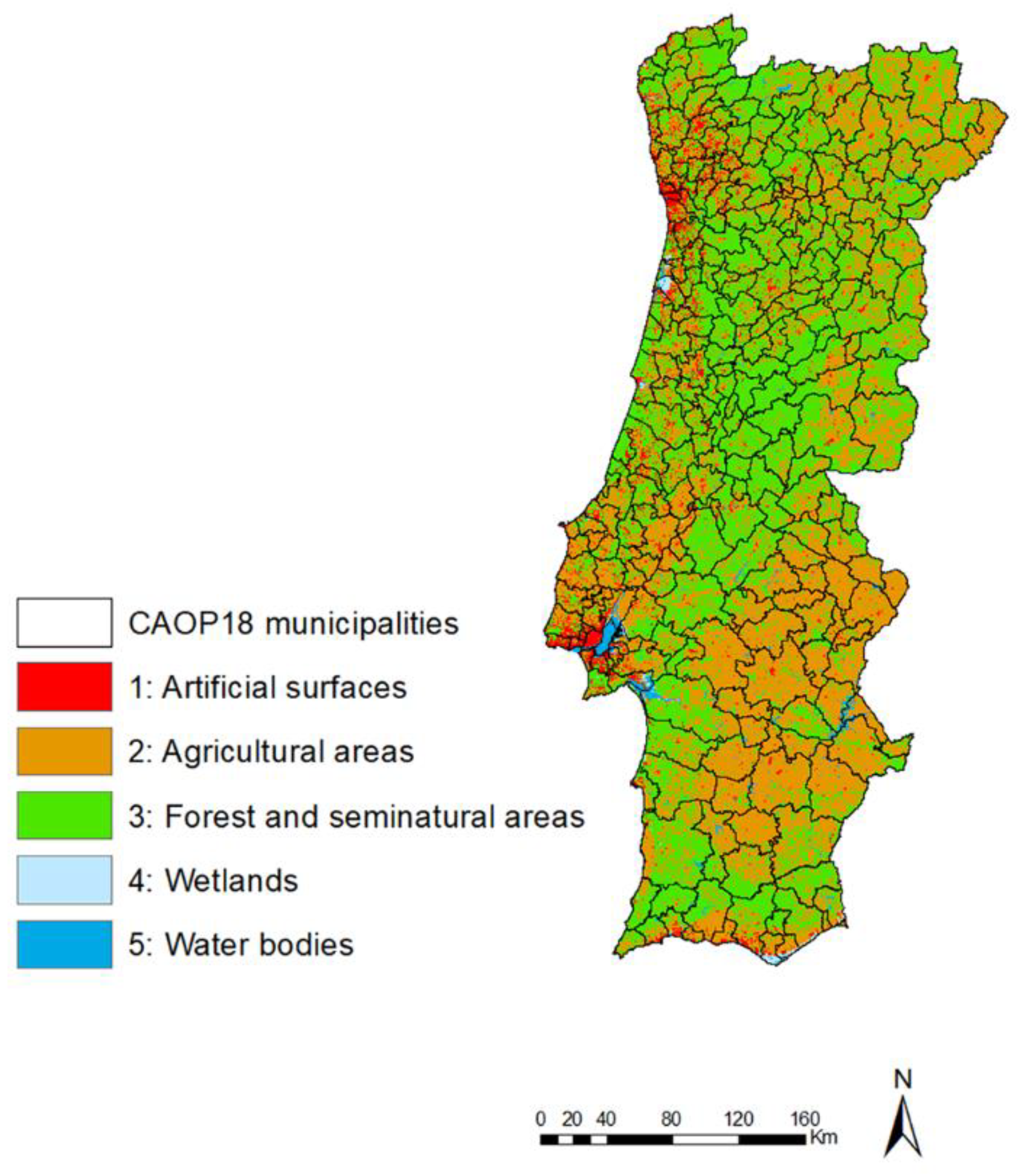
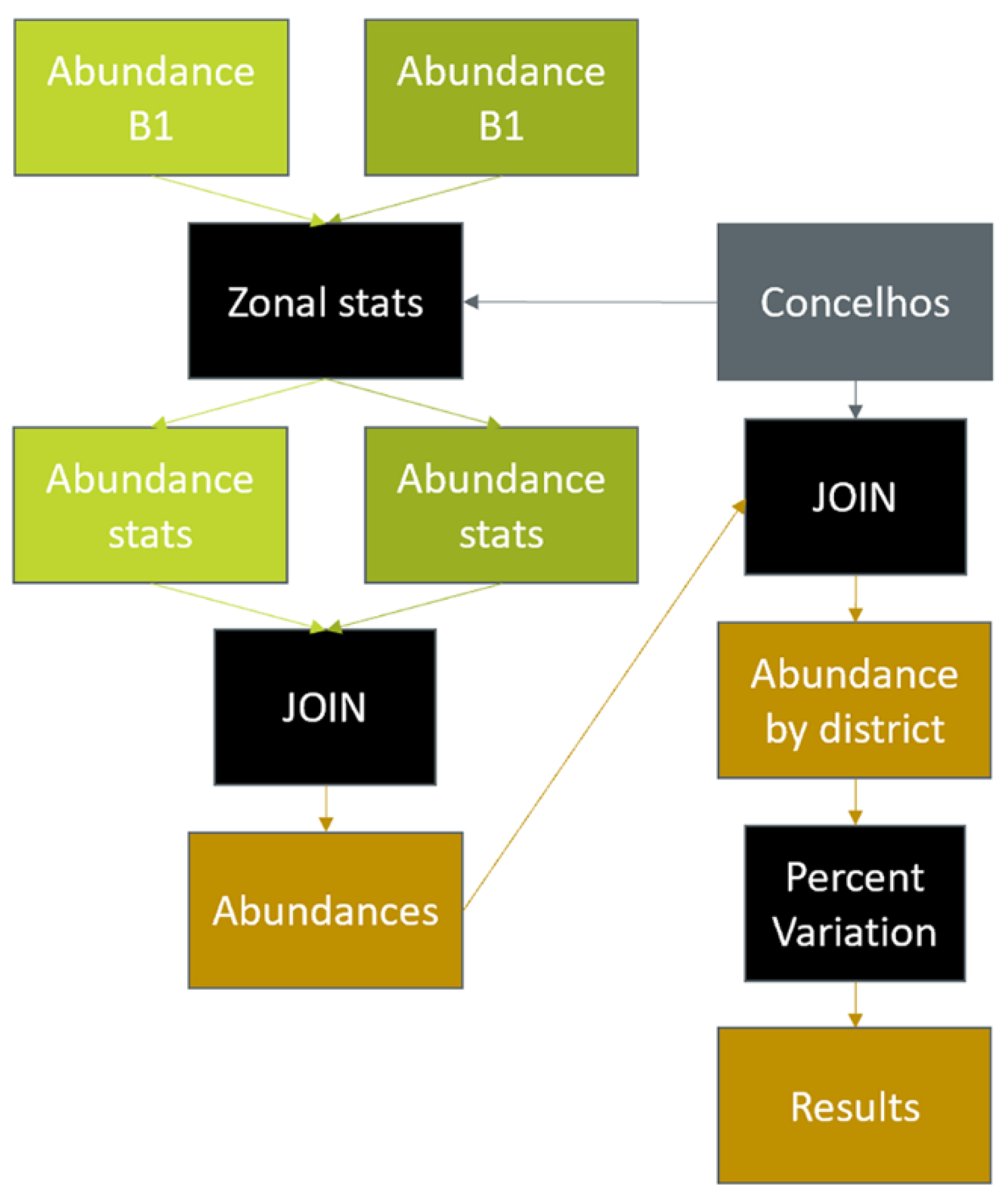
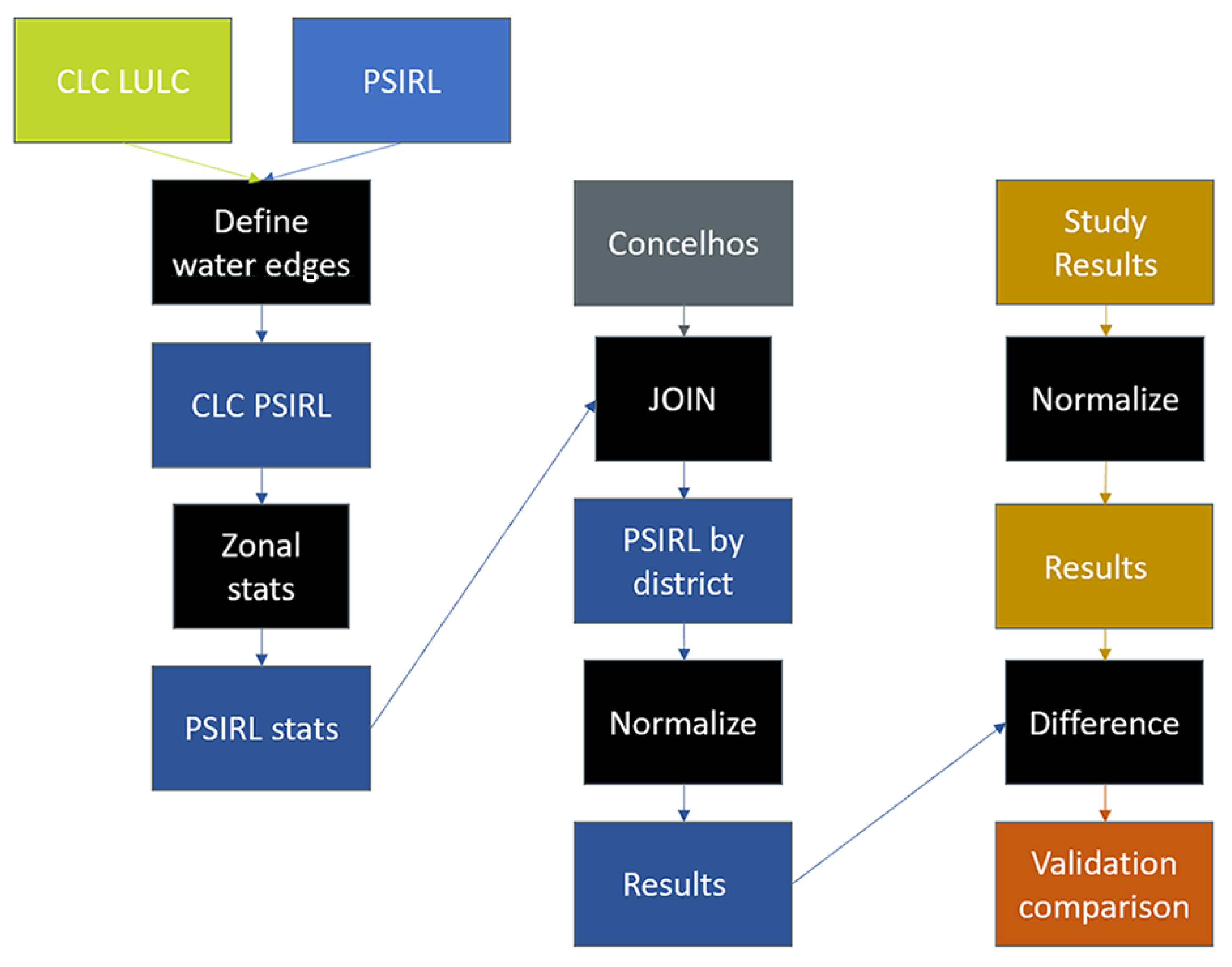
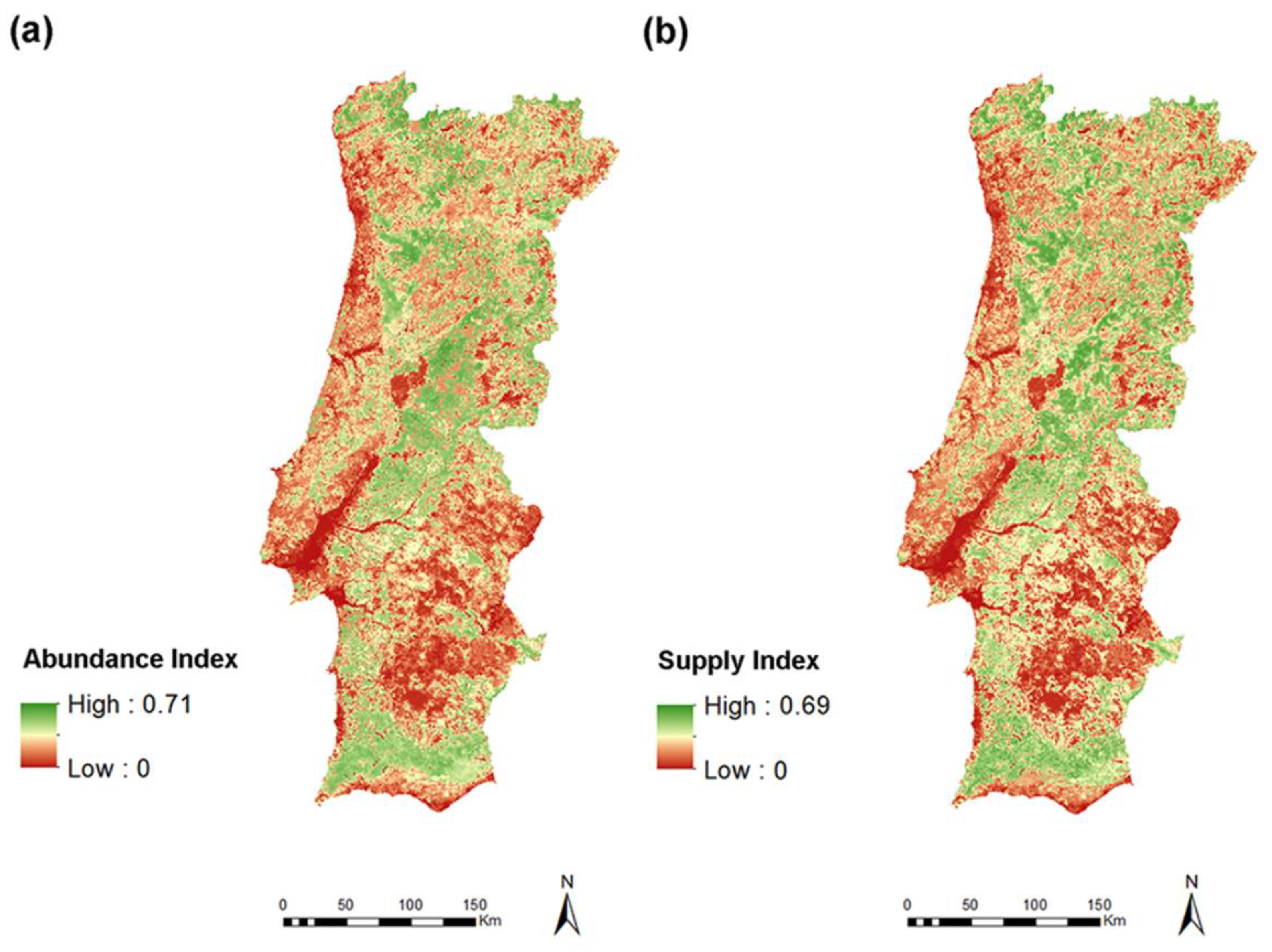
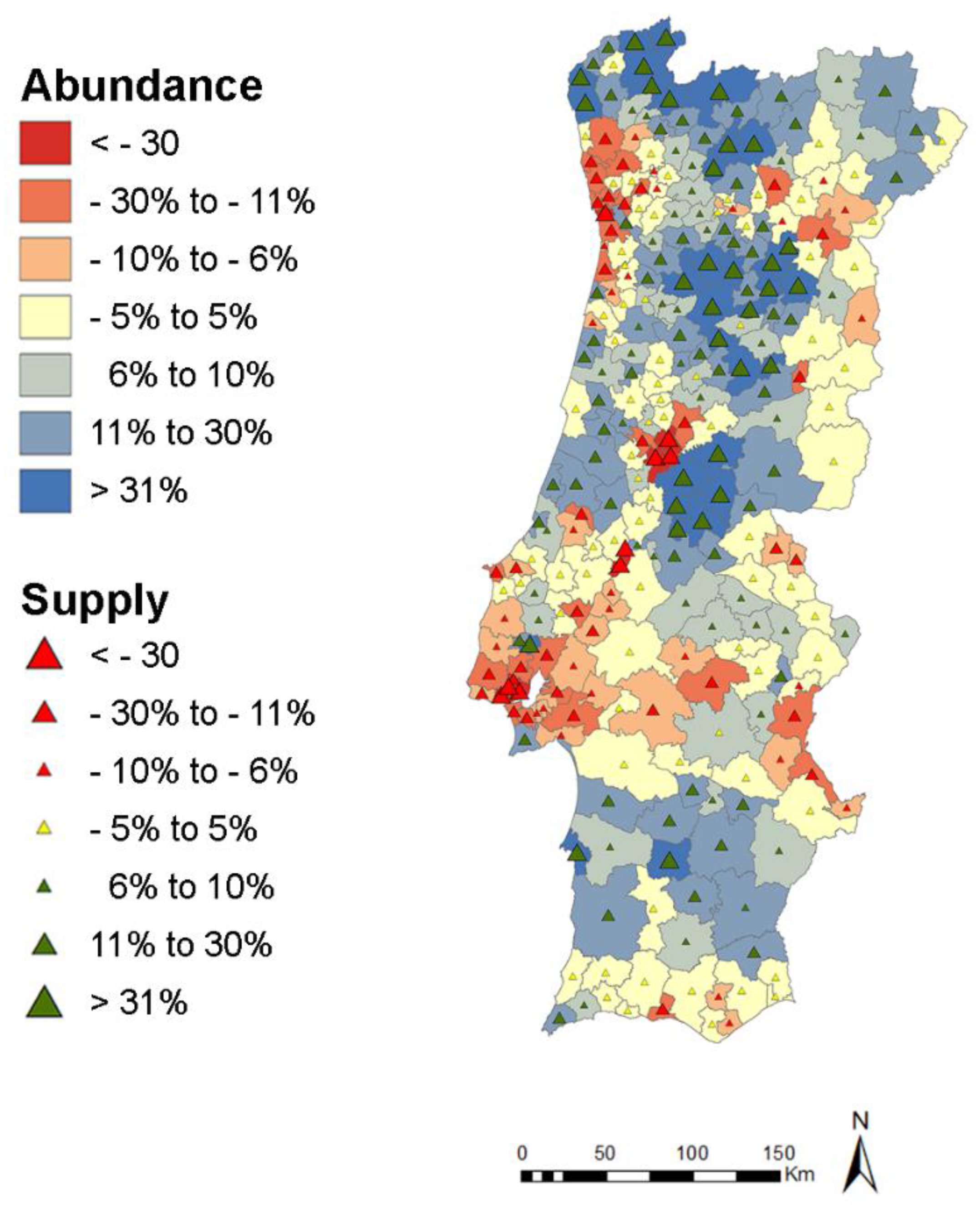

| LULC | 1990 LULC (%) | 2018 PV (%) |
|---|---|---|
| Artificial surfaces | 1.90 | 101.27% |
| Agricultural areas | 48.70 | −1.83% |
| Forests and seminatural areas | 47.92 | −3.00% |
| Wetlands | 0.32 | 7.08% |
| Water bodies | 1.15 | 33.59% |
| Year | Index | Min | Max | Mean | Std |
|---|---|---|---|---|---|
| 1990 | Abundance | 0.000 | 0.700 | 0.274 | 0.163 |
| 1990 | Supply | 0.000 | 0.709 | 0.274 | 0.163 |
| 2018 | Abundance | 0.000 | 0.711 | 0.298 | 0.174 |
| 2018 | Supply | 0.000 | 0.694 | 0.298 | 0.174 |
Publisher’s Note: MDPI stays neutral with regard to jurisdictional claims in published maps and institutional affiliations. |
© 2021 by the authors. Licensee MDPI, Basel, Switzerland. This article is an open access article distributed under the terms and conditions of the Creative Commons Attribution (CC BY) license (https://creativecommons.org/licenses/by/4.0/).
Share and Cite
Wentling, C.; Campos, F.S.; David, J.; Cabral, P. Pollination Potential in Portugal: Leveraging an Ecosystem Service for Sustainable Agricultural Productivity. Land 2021, 10, 431. https://doi.org/10.3390/land10040431
Wentling C, Campos FS, David J, Cabral P. Pollination Potential in Portugal: Leveraging an Ecosystem Service for Sustainable Agricultural Productivity. Land. 2021; 10(4):431. https://doi.org/10.3390/land10040431
Chicago/Turabian StyleWentling, Caroline, Felipe S. Campos, João David, and Pedro Cabral. 2021. "Pollination Potential in Portugal: Leveraging an Ecosystem Service for Sustainable Agricultural Productivity" Land 10, no. 4: 431. https://doi.org/10.3390/land10040431
APA StyleWentling, C., Campos, F. S., David, J., & Cabral, P. (2021). Pollination Potential in Portugal: Leveraging an Ecosystem Service for Sustainable Agricultural Productivity. Land, 10(4), 431. https://doi.org/10.3390/land10040431







